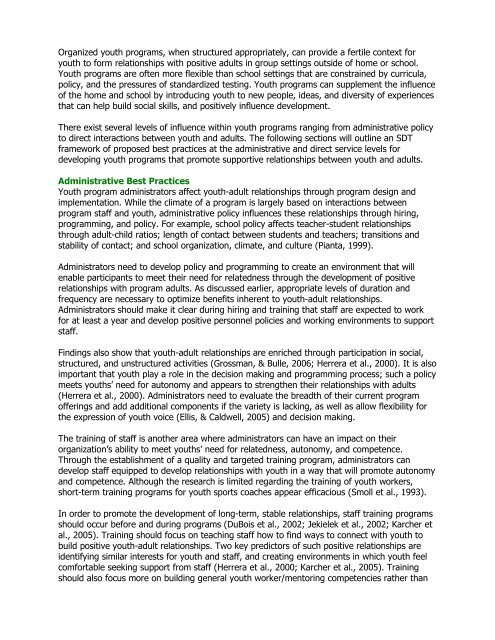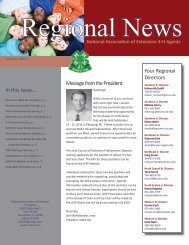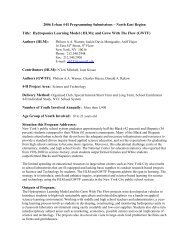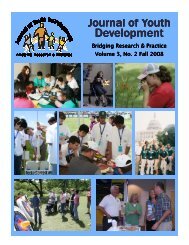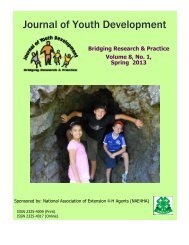Organized youth programs, when structured appropriately, can provide a fertile context foryouth to form relationships with positive adults in group settings outside <strong>of</strong> home or school.Youth programs are <strong>of</strong>ten more flexible than school settings that are constrained by curricula,policy, and the pressures <strong>of</strong> standardized testing. Youth programs can supplement the influence<strong>of</strong> the home and school by introducing youth to new people, ideas, and diversity <strong>of</strong> experiencesthat can help build social skills, and positively influence development.There exist several levels <strong>of</strong> influence within youth programs ranging from administrative policyto direct interactions between youth and adults. The following sections will outline an SDTframework <strong>of</strong> proposed best practices at the administrative and direct service levels fordeveloping youth programs that promote supportive relationships between youth and adults.Administrative Best PracticesYouth program administrators affect youth-adult relationships through program design andimplementation. While the climate <strong>of</strong> a program is largely based on interactions betweenprogram staff and youth, administrative policy influences these relationships through hiring,programming, and policy. For example, school policy affects teacher-student relationshipsthrough adult-child ratios; length <strong>of</strong> contact between students and teachers; transitions andstability <strong>of</strong> contact; and school organization, climate, and culture (Pianta, 1999).Administrators need to develop policy and programming to create an environment that willenable participants to meet their need for relatedness through the development <strong>of</strong> positiverelationships with program adults. As discussed earlier, appropriate levels <strong>of</strong> duration andfrequency are necessary to optimize benefits inherent to youth-adult relationships.Administrators should make it clear during hiring and training that staff are expected to workfor at least a year and develop positive personnel policies and working environments to supportstaff.Findings also show that youth-adult relationships are enriched through participation in social,structured, and unstructured activities (Grossman, & Bulle, 2006; Herrera et al., 2000). It is alsoimportant that youth play a role in the decision making and programming process; such a policymeets youths’ need for autonomy and appears to strengthen their relationships with adults(Herrera et al., 2000). Administrators need to evaluate the breadth <strong>of</strong> their current program<strong>of</strong>ferings and add additional components if the variety is lacking, as well as allow flexibility forthe expression <strong>of</strong> youth voice (Ellis, & Caldwell, 2005) and decision making.The training <strong>of</strong> staff is another area where administrators can have an impact on theirorganization’s ability to meet youths’ need for relatedness, autonomy, and competence.Through the establishment <strong>of</strong> a quality and targeted training program, administrators candevelop staff equipped to develop relationships with youth in a way that will promote autonomyand competence. Although the research is limited regarding the training <strong>of</strong> youth workers,short-term training programs for youth sports coaches appear efficacious (Smoll et al., 1993).In order to promote the development <strong>of</strong> long-term, stable relationships, staff training programsshould occur before and during programs (DuBois et al., 2002; Jekielek et al., 2002; Karcher etal., 2005). Training should focus on teaching staff how to find ways to connect with youth tobuild positive youth-adult relationships. Two key predictors <strong>of</strong> such positive relationships areidentifying similar interests for youth and staff, and creating environments in which youth feelcomfortable seeking support from staff (Herrera et al., 2000; Karcher et al., 2005). Trainingshould also focus more on building general youth worker/mentoring competencies rather than
preparing staff to deal with specific at-risk behaviors since general levels <strong>of</strong> mentoring selfefficacyhave been shown to be better predictors <strong>of</strong> positive relationships than youths’ at-riskstatus (Karcher, 2005). Such a training program could consist <strong>of</strong> pre-mentoring workshopssupplemented by regular, scheduled contact with program supervisors once mentoring begins.Continued administrative oversight <strong>of</strong> mentoring relationship helps ensure programimplementation (DuBois et al., 2002; Jekielek et al., 2002). Research shows such supervisionalso leads to increased contact between mentors and mentees (Herrera et al., 2000).Staff should understand the balance they need to establish in terms <strong>of</strong> structure, support, andactivity participation. Research shows that youth gain the greatest benefits when adults providemoderate levels <strong>of</strong> structured and unstructured activities. Staff should also <strong>of</strong>fer support basedupon agreed-upon expectations for appropriate behavior (Langhout et al., 2004). Program staffalso need to understand the perspectives and experiences <strong>of</strong> youth, both as individuals and asmembers <strong>of</strong> unique contexts (i.e. family, community, ethnic, etc.; Larson et al., 2005).Policy and staff training can create an environment and culture where supportive adultrelationships thrive. Although further research is needed to validate these proposed bestpractices, findings from other contexts support their effectiveness. It is also worth noting thatrelationships between administrators and program youth leaders may affect relationshipsbetween youth leaders and youth. Accordingly, one way to prepare youth leaders to fosterfeelings <strong>of</strong> relatedness, autonomy, and competence among the youth is to provide these sameconditions for youth workers. Administrators’ efforts to enact policy, programming, and trainingprocedures lay the foundation for the development <strong>of</strong> supportive relationships between youthand program staff. The following section presents ideas regarding how staff can mosteffectively interact with youth in order to promote competence and autonomy.Interpersonal Best PracticesDirect interactions between youth and adults are the touchstone <strong>of</strong> youth’s feelings <strong>of</strong>connectedness to youth programs (Pearce, & Larson, 2006). Pianta (1999) suggests that suchrelationships can be thought <strong>of</strong> as a system comprised <strong>of</strong>: representations, feedbackmechanisms, tolerances, timing <strong>of</strong> interactions, and contingency <strong>of</strong> interactions. While there areseveral different approaches to establishing supportive relationships with youth, manysimilarities exist across approaches that suggest that the provision <strong>of</strong> opportunities forautonomy, competence, and relatedness lead to effective youth-adult relationships.Autonomy-supportive teaching styles are those in which teachers provide a sense <strong>of</strong> volition bybeing sensitive to students’ needs, and also affording choices to students (Soenens, &Vansteenkiste, 2005). Adults can support autonomy by providing information about options andactions; acknowledging feelings; incorporating student perspectives into activities; providingoptimally challenging tasks; providing structure and guidance that demonstrate the reasons forcertain behaviors; and minimizing a performance-based climate (Eisenman, 2007). Autonomysupport can also occur in environments that include opportunities for youth to evaluate theirown performances, have choices, learn how to find information, and understand rationales forbehavior change that are relevant to them (Hill, & Sibthorp, 2006).Autonomy-supportive contexts are those that provide youth with a sense <strong>of</strong> personal choice andinvolvement, and are provided by adults who actively engage youth in being the agents <strong>of</strong> theirexperiences. In coaching contexts, group structures that are autonomy-supportive and masteryfocusedcan promote self-determination to engage in physical activity (Standage, Duda, &Ntoumanis, 2003). When coaches provide adolescent athletes with a sense <strong>of</strong> choice,meaningful rationale for behaviors, and freedom from external pressure, athletes are more
- Page 2 and 3:
Winter 2008Volume 3 Number 3Editor
- Page 5:
Examining the Potential Unintended
- Page 8 and 9: centered, multidisciplinary approac
- Page 10 and 11: Volume 3, Number 3, Winter 2008Arti
- Page 12 and 13: fostering skill learning and positi
- Page 14 and 15: Table 1Participation in out-of-scho
- Page 16 and 17: ResultsOur analyses were conducted
- Page 18 and 19: watching TV, playing video games or
- Page 20 and 21: Accordingly, this research augments
- Page 22 and 23: Dotterer, A.M., McHale, S.M., & Cro
- Page 24 and 25: A Descriptive View of the 4-H Club
- Page 26 and 27: In this paper, the results of a cro
- Page 28 and 29: section is a set of statements that
- Page 30 and 31: Table 3Experience in the 4-H clubNo
- Page 32 and 33: significantly higher than Caucasian
- Page 34 and 35: p
- Page 36 and 37: This study focused only on the 4-H
- Page 38 and 39: Theokas, C., Lerner, J.V., Phelps,
- Page 40 and 41: Volume 3, Number 3, Winter 2008Arti
- Page 42 and 43: potential for reaching audiences, d
- Page 44 and 45: Putting Marketing Concepts into Pra
- Page 46 and 47: 2. Find out what others think about
- Page 48 and 49: Diem, K.G. (1994). What do youth li
- Page 50 and 51: Promoting Supportive Relationships
- Page 52 and 53: focused on youth-adult relationship
- Page 54 and 55: Conversely, more modern educational
- Page 56 and 57: perhaps most importantly, the effic
- Page 60 and 61: likely to internalize the positive
- Page 62 and 63: Ellis, J.M., & Caldwell, L.L. (2005
- Page 64 and 65: Schweinle, A., Meyer, D.K., & Turne
- Page 66 and 67: Volume 3, Number 3, Winter 2008Arti
- Page 68 and 69: This study uses the “5 Cs” mode
- Page 70 and 71: ResultsIn this analysis 48 codes we
- Page 72 and 73: Table 3Inductive Codes Classified b
- Page 74 and 75: CompetenceCompetence in organized s
- Page 76 and 77: ecause of him (the coach)…. You d
- Page 78 and 79: practices and competitions, the gir
- Page 80 and 81: Eccles, J.S., & Gootmann, J.A. (Eds
- Page 82 and 83: Smoll, F.L., & Smith, R.E. (2002).
- Page 84 and 85: Volume 3, Number 3, Winter 2008Arti
- Page 86 and 87: The present work builds upon that o
- Page 88 and 89: MethodSample and Data CollectionAs
- Page 90 and 91: (scores ranging from 0 to 8) and a
- Page 92 and 93: Table 2Paired Sample T-tests Compar
- Page 94 and 95: Hypotheses 5 and 6 were tested by c
- Page 96 and 97: De Coverly Veale, D.M.W. (1987). Ex
- Page 98 and 99: Story, M., Neumark-Sztainer, D., Sh
- Page 100 and 101: Volume 3, Number 3, Winter 2008Arti
- Page 102 and 103: Cronbach’s Alpha Score For Youth
- Page 104 and 105: 12 to 18 years old. Fourteen of the
- Page 106 and 107: Therefore, there was a mixed relati
- Page 108 and 109:
Youth respondents identified two ob
- Page 110 and 111:
are developed through working in a
- Page 112 and 113:
Seevers, B.S., & Dormody, T.J. (199
- Page 114 and 115:
Volume 3, Number 3, Winter 2008Arti
- Page 116 and 117:
With the many opportunities that yo
- Page 118 and 119:
meaningfully reduced involving dedu
- Page 120 and 121:
StaffingXTime/Schedule X X XTrainin
- Page 122 and 123:
“Involving adults that will allow
- Page 124 and 125:
“They can't drive or do not have
- Page 126 and 127:
page in understanding why youth voi
- Page 128 and 129:
Parker, L. (1999). If all youth ser
- Page 130 and 131:
Volume 3, Number 3, Winter 2008Arti
- Page 132 and 133:
However, the literature is mixed in
- Page 134 and 135:
group was the quality of the progra
- Page 136 and 137:
Table 1Reasons for Non-Attendance:
- Page 138 and 139:
easons given was six. Sixty-three p
- Page 140 and 141:
The non-family-related activities t
- Page 142 and 143:
“Catch ‘Em Being Good:”An Ext
- Page 144 and 145:
In 2001, the WVUES received a schoo
- Page 146 and 147:
to leverage the resources of the co
- Page 148 and 149:
4. Most primary behavior incidents
- Page 150 and 151:
Recommendations for developing prog
- Page 152 and 153:
Cross-Cultural UnderstandingThrough
- Page 154 and 155:
that plague these nations such as p
- Page 156 and 157:
2003). Youth leadership training in
- Page 158 and 159:
• enable these young people to pa
- Page 160 and 161:
We believe that the USPORT program
- Page 162 and 163:
West Virginia’s Response to theRo
- Page 164 and 165:
Ensuring good oral health requires
- Page 166 and 167:
Table 1Correlations between Planner
- Page 168 and 169:
problems in this rural state…This
- Page 170 and 171:
Volume 3, Number 3, Winter 2008Arti
- Page 172 and 173:
vacuum. Determination of factors, a
- Page 174 and 175:
ReferencesBaldwin, C., & Caldwell,
- Page 176 and 177:
Volume 3, Number 3, Winter 2008Arti
- Page 178 and 179:
Purpose of StudyThe purpose of this
- Page 180 and 181:
Students in the High computer gamin
- Page 182 and 183:
Do Higher Levels of 4-H LeadershipA
- Page 184 and 185:
IntroductionEmotional Intelligence
- Page 186 and 187:
second section examined demographic
- Page 188 and 189:
a constructive manner. The group is
- Page 190 and 191:
differences in the scores for the 1
- Page 192 and 193:
Adaptability include “Reality Tes
- Page 194 and 195:
ReferencesAmerican Academy of Pedia
- Page 196 and 197:
Healthy Kids, Healthy Families:A Co
- Page 198 and 199:
and a half million U.S. youth (ages
- Page 200 and 201:
Families. In partnering counties, p
- Page 202 and 203:
Healthy Families was then offered a
- Page 204 and 205:
Kamberelis, G., & Dimitriadis, G. (
- Page 206 and 207:
Volume 3, Number 3, Winter 2008Arti
- Page 208 and 209:
Change It Up!What Girls Say About R
- Page 210:
In addition, the study summarizes t


